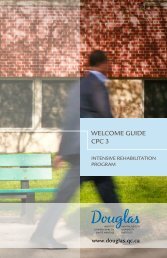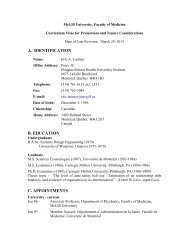Chapter 5What Works <strong>in</strong> <strong>Suicide</strong> Prevention?Each reserve is different and I f<strong>in</strong>d each reserve lacks ... One reserve may get all theresources … well, they can access the funds or programm<strong>in</strong>g, but another reserve doesn’thave that opportunity or don’t have the people or committed <strong>in</strong>dividuals with<strong>in</strong> theirreserve that could set up programs for them or f<strong>in</strong>d the money where they could help outtheir community members or the youth (First Nation youth).Conventional mental health approaches to suicide emphasize the identification and treatment of <strong>in</strong>dividualsat risk. This is one essential component of any effective <strong>in</strong>tervention. Most <strong>Aborig<strong>in</strong>al</strong> communities areunderserviced, and it is not always possible for <strong>in</strong>dividuals with depression, substance abuse problems, andfamily crises to obta<strong>in</strong> appropriate help. Basic services must be made accessible to <strong>Aborig<strong>in</strong>al</strong> people liv<strong>in</strong>g<strong>in</strong> remote communities and <strong>in</strong> urban centres. At the same time, the very high rates of suicide, attemptedsuicide, and suicidal ideation among youth <strong>in</strong> many <strong>Aborig<strong>in</strong>al</strong> communities <strong>in</strong>dicate that the problem is notjust <strong>in</strong>dividual but <strong>in</strong>volves community-wide issues. As such, a community-based approach to preventionis essential.Recent reports from government and professional advisory groups agree that there is an urgent need for moreresearch to identify effective ways of prevent<strong>in</strong>g suicide (Silverman, 2001; Goldsmith et al., 2002; AmericanAcademy of Child and Adolescent Psychiatry, 2001b). Reviews of prevention programs specifically designedto reduce suicide among <strong>Aborig<strong>in</strong>al</strong> people have found that there are very few well-evaluated studies todate (Middlebrook et al., 2001; Advisory Group on <strong>Suicide</strong> Prevention, 2003). Nevertheless, there is someconsensus on current best practices at the levels of <strong>in</strong>dividual and community heal<strong>in</strong>g, cl<strong>in</strong>ical <strong>in</strong>tervention,and prevention. Similar strategies have been outl<strong>in</strong>ed <strong>in</strong> documents prepared by various groups <strong>in</strong> <strong>Canada</strong>,Australia, and the United States (American Academy of Child and Adolescent Psychiatry, 2001a; 2001b).Several useful reviews of strategies and programs appropriate for <strong>Aborig<strong>in</strong>al</strong> communities <strong>in</strong> <strong>Canada</strong> arealso available (e.g. Devl<strong>in</strong>, 2001a; 2001b; Gard<strong>in</strong>er and Gaida, 2002; White and Jodo<strong>in</strong>, 2003).This chapter reviews available <strong>in</strong>formation on what types of programs and <strong>in</strong>terventions may be effectivefor suicide prevention, the treatment of suicidal <strong>in</strong>dividuals, and support for those affected by the suicideof a friend or family. The first section briefly outl<strong>in</strong>es the levels and types of prevention. The next sectionreviews the elements of successful suicide prevention programs and discusses the few programs that havebeen shown to be effective <strong>in</strong> systematic evaluation or outcome studies. Chapter 6 discusses issues <strong>in</strong>adapt<strong>in</strong>g prevention programs to <strong>Aborig<strong>in</strong>al</strong> communities and summarizes guidel<strong>in</strong>es for best practices.Appendix A describes some recommended programs <strong>in</strong> more detail.Levels of PreventionPrimary prevention (act<strong>in</strong>g “before the fact”) aims to reduce suicide risk by improv<strong>in</strong>g the mental healthof a population. This k<strong>in</strong>d of prevention strategy can address a wide range of social or mental healthproblems, and its positive impact goes well beyond the problem of suicide (Mrazek and Haggerty, 1994).Examples <strong>in</strong>clude life skills education <strong>in</strong> schools, parent<strong>in</strong>g programs, and provision of accessible andeffective mental health services for a population.81
Chapter 5Secondary prevention (early <strong>in</strong>tervention or treatment) aims to help potentially suicidal <strong>in</strong>dividuals eitherbefore they <strong>in</strong>jure themselves or dur<strong>in</strong>g a suicidal crisis. Examples <strong>in</strong>clude telephone crisis l<strong>in</strong>es as well ascounsell<strong>in</strong>g, support, and supervision for persons who have expressed thoughts of suicide or have givenother <strong>in</strong>dications of be<strong>in</strong>g at risk.Tertiary prevention (or postvention) focuses on persons who have been affected by suicidal behaviour: suicideattempters who are at high risk for a recurrence, bereaved friends or family members who are also at risk for<strong>in</strong>creased distress, psychiatric morbidity, and the development of suicidal behaviour. Postvention is oftenaccomplished through counsell<strong>in</strong>g and other forms of support (Kirmayer et al., 1994b).<strong>Suicide</strong> prevention methods can be targeted at different levels: the community, the family, or the vulnerable<strong>in</strong>dividual. It can also address different time frames: the sources of vulnerability and resilience <strong>in</strong> <strong>in</strong>fancyand childhood, the period of <strong>in</strong>creas<strong>in</strong>g vulnerability <strong>in</strong> adolescence, the immediate precursors tosuicidal behaviour, or the crisis situation itself. These levels, <strong>in</strong> turn, are reflected <strong>in</strong> the most appropriatelocation of <strong>in</strong>terventions: community centres or other places where youth and their parents can bereached; the school or other sett<strong>in</strong>gs where youth congregate; and primary health care or social services,mental health services <strong>in</strong> community cl<strong>in</strong>ics, or mobile crisis teams. Through specific policies, organizedoutreach, or mass media, <strong>in</strong>terventions may be directed to whole communities or populations. There isgeneral agreement that programs directed to several of these levels at the same time will achieve the bestoutcomes. However, some types of service may be more feasible <strong>in</strong> a given community.In pr<strong>in</strong>ciple, anyth<strong>in</strong>g that reduces a risk factor or <strong>in</strong>creases a protective factor will help prevent asuicide. Although most research and practice focuses on <strong>in</strong>dividual-level factors, it is likely that there arecommunity-level and population-level factors that have powerful effects. However, there is controversy<strong>in</strong> the area of prevention as to whether to attempt to <strong>in</strong>fluence a whole population or to screen for andtarget high-risk groups (Rose, 1993). Large-scale programs are costly, may not reach the most vulnerable<strong>in</strong>dividuals, and may have only small effects on any given person. Some prevention programs may alsohave potential negative effects, particularly with people for whom they were not specifically designed.Table 5-1 summarizes some of the advantages and disadvantages to <strong>in</strong>dividual- and population-levelapproaches. The high-risk <strong>in</strong>dividual approach can tailor <strong>in</strong>terventions to the needs of a particulargroup of <strong>in</strong>dividuals, and deliver it <strong>in</strong> a way that is most appeal<strong>in</strong>g to them. This will likely <strong>in</strong>crease themotivation of participants. Direct contact with <strong>in</strong>dividuals is also more <strong>in</strong>terest<strong>in</strong>g for cl<strong>in</strong>icians andother helpers who may experience reward<strong>in</strong>g <strong>in</strong>teractions. The focus on vulnerable <strong>in</strong>dividuals is usuallya cost-effective use of resources. This focus also allows the helper to consider the drawbacks of any<strong>in</strong>tervention <strong>in</strong> an <strong>in</strong>dividual case, and so m<strong>in</strong>imize the risk of harm.82
- Page 1 and 2:
Suicide Among Aboriginal Peoplein C
- Page 3 and 4:
Aboriginal Healing Foundation75 Alb
- Page 6 and 7:
Table of ContentsPreface...........
- Page 8 and 9:
Table of ContentsCultural and Lingu
- Page 10:
PrefaceThis report was prepared und
- Page 14 and 15:
GlossaryAmbivalence - Ambivalence r
- Page 16 and 17:
GlossaryParasuicide - Any acute, in
- Page 18 and 19:
Chapter 1IntroductionWhen I was 14
- Page 20 and 21:
Chapter 1Definitions of Suicide and
- Page 22 and 23:
Chapter 1Methods of Studying Suicid
- Page 24 and 25:
Chapter 1suicide attempts (Marttune
- Page 26 and 27:
Chapter 1A central problem for cros
- Page 28 and 29:
Chapter 2The Epidemiology of Suicid
- Page 30 and 31:
Chapter 2the economic status of Abo
- Page 32 and 33:
Chapter 2No study to date has syste
- Page 34 and 35:
Chapter 2Despite the overall patter
- Page 36 and 37:
Chapter 2Figure 2-6) Average Annual
- Page 38 and 39:
Chapter 2are only a portion of thos
- Page 40 and 41:
Chapter 2Figure 2-9) Suicide Rates
- Page 42 and 43:
Chapter 2Indeed, the rising rate of
- Page 44 and 45:
Chapter 2Figure 2-11) Number of Dea
- Page 46 and 47:
Chapter 2Rate per 100,000 populatio
- Page 48 and 49: Chapter 2There are only a handful o
- Page 50 and 51: Chapter 3Origins of Suicide: Indivi
- Page 52 and 53: Chapter 3Anxiety disorders also car
- Page 54 and 55: Chapter 3Many of the factors associ
- Page 56 and 57: Chapter 3American Indians compared
- Page 58 and 59: Chapter 3genetic and constitutional
- Page 60 and 61: Chapter 3Single-parent families are
- Page 62 and 63: Chapter 3Hopelessness, Problem Solv
- Page 64 and 65: Chapter 3higher rates of suicidal b
- Page 66 and 67: Chapter 3Physical EnvironmentSuicid
- Page 68 and 69: Chapter 31990; Chandler, 1994). Thi
- Page 70 and 71: Chapter 3Risk FactorsDepressionSubs
- Page 72 and 73: Chapter 4Origins of Suicide: Social
- Page 74 and 75: Chapter 4Reserves, Settlements, and
- Page 76 and 77: Chapter 4Traditionalism versus accu
- Page 78 and 79: Chapter 4are equivalent in seriousn
- Page 80 and 81: Chapter 4society (Levy and Kunitz,
- Page 82 and 83: Chapter 4those of mother and homema
- Page 84 and 85: Chapter 4Duncan Campbell Scott, Dep
- Page 86 and 87: Chapter 4Traditional Aboriginal com
- Page 88 and 89: Chapter 4Feehan, 1996; Grant, 1996;
- Page 90 and 91: Chapter 4The Child Welfare System a
- Page 92 and 93: Chapter 4Aboriginal communities and
- Page 94 and 95: Chapter 4had extremely high rates.
- Page 96 and 97: Chapter 4Figure 4-2) Transgeneratio
- Page 100 and 101: Chapter 5Table 5-1) Strategies of I
- Page 102 and 103: Chapter 5Effective Suicide Preventi
- Page 104 and 105: Chapter 5closet rods that give way
- Page 106 and 107: Chapter 5The American Indian Life S
- Page 108 and 109: Chapter 51) school-based and commun
- Page 110 and 111: Chapter 5reduce suicides that follo
- Page 112 and 113: Chapter 5Although they may visit a
- Page 114 and 115: Chapter 6Conclusion: Understanding
- Page 116 and 117: Chapter 6Figure 6-1) An Integrative
- Page 118 and 119: Chapter 6in large urban settings th
- Page 120 and 121: Chapter 6there’s like a program s
- Page 122 and 123: Chapter 6Figure 6-2) Levels of Inte
- Page 124 and 125: Chapter 6Planning and CoordinationA
- Page 126 and 127: Chapter 62) The response to the cri
- Page 128: Chapter 6Often, suicide is a respon
- Page 131 and 132: Appendix AASIST participants receiv
- Page 133 and 134: Appendix AThe Training for Youth Ed
- Page 135 and 136: Appendix AThe program has continued
- Page 137 and 138: Appendix Awith the creation and imp
- Page 139 and 140: Appendix AContact Information for R
- Page 142 and 143: Appendix BAdditional Resources: Man
- Page 144: Appendix BAboriginal Healing and We
- Page 147 and 148: Appendix CNational Aboriginal Healt
- Page 149 and 150:
References——— (1987). Unravel
- Page 151 and 152:
ReferencesBeck, A.T., R.A. Steer, M
- Page 153 and 154:
ReferencesBrent, D.A., J.A. Perper,
- Page 155 and 156:
References——— (1995). The Pro
- Page 157 and 158:
ReferencesDevereux, G. (1961). Moha
- Page 159 and 160:
References——— (2005b). In wha
- Page 161 and 162:
ReferencesGardiner, H. and B. Gaida
- Page 163 and 164:
ReferencesGuo, B. and C. Harstall (
- Page 165 and 166:
ReferencesHoberman, H.M. and B.D. G
- Page 167 and 168:
ReferencesJong, M. (2004). Managing
- Page 169 and 170:
ReferencesKouri, R. (2003). Persona
- Page 171 and 172:
References——— (1997). Suicide
- Page 173 and 174:
ReferencesMatheson, L. (1996). The
- Page 175 and 176:
ReferencesNeimeyer, R.A., B. Fortne
- Page 177 and 178:
ReferencesPirkis, J.E., C.E. Irwin,
- Page 179 and 180:
ReferencesRutz, W. (2001). Preventi
- Page 181 and 182:
References——— (1992). Marriag
- Page 183 and 184:
ReferencesTrimble, J. and B. Medici
- Page 185 and 186:
ReferencesWebb, J.P. and W. Willard
















